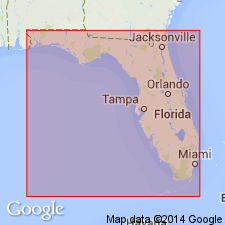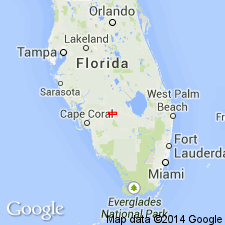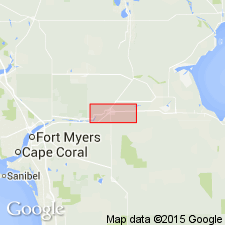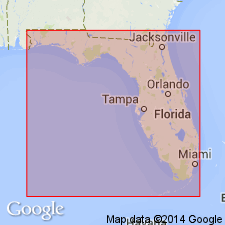
- Usage in publication:
-
- Bee Branch limestone member
- Modifications:
-
- [Incidental mention]
- AAPG geologic province:
-
- Florida platform
Summary:
Pg. 192 (table 1). Bee Branch limestone member of Caloosahatchee marl. Table shows Bee Branch limestone as middle member of Caloosahatchee; underlies Ayers Landing member (new); overlies Fort Denaud member (new). [Age is Pleistocene.]
Source: US geologic names lexicon (USGS Bull. 1200, p. 269).

- Usage in publication:
-
- Bee Branch limestone member
- Modifications:
-
- Principal reference
- Dominant lithology:
-
- Limestone
- Marl
- AAPG geologic province:
-
- Florida platform
Summary:
Pg. 136 (fig. 4), 143-144. Bee Branch limestone member of Caloosahatchee marl. Relatively hard solution-riddled marine limestone or marl unit. Consists of two principal facies, one of which, represented at type locality, is a massive hard calcareous ledge-forming bed; the other is softer, less consolidated, more arenaceous, and more distinctly concretionary. Thickness a few inches to about 5 feet; averages 2.5 feet. Conformably overlies Fort Denaud member; conformably underlies the Ayers Landing member. Where erosion has been extensive, overlying beds may belong to either Fort Thompson or Pamlico formation, and contact is unconformable. [Age is Pleistocene.]
Type locality: along Caloosahatchee River near its confluence with tributary called Bee Branch, Hendry Co., southern FL.
Source: US geologic names lexicon (USGS Bull. 1200, p. 269).

- Usage in publication:
-
- Bee Branch member
- Modifications:
-
- Areal extent
- AAPG geologic province:
-
- Florida platform
Summary:
Pg. 41 (fig. 7), 58-61. Bee Branch member of Caloosahatchee marl. Relatively hard solution-riddled marine limestone or marl unit of the Caloosahatchee marl. Overlies brackish-water marl (lower Caloosahatchee beds); underlies upper shell bed (upper Caloosahatchee shell bed). [Report does not use either Fort Denaud member or Ayers Landing marl member.] Age is Pleistocene.
Source: Publication; US geologic names lexicon (USGS Bull. 1200, p. 269).

- Usage in publication:
-
- Bee Branch Member
- Modifications:
-
- Age modified
- AAPG geologic province:
-
- Florida platform
Summary:
Age of the Bee Branch Member of the Caloosahatchee Formation in southern FL shown as early or middle Pleistocene, deposition having occurred more than 400,000 years ago.
Source: GNU records (USGS DDS-6; Reston GNULEX).
For more information, please contact Nancy Stamm, Geologic Names Committee Secretary.
Asterisk (*) indicates published by U.S. Geological Survey authors.
"No current usage" (†) implies that a name has been abandoned or has fallen into disuse. Former usage and, if known, replacement name given in parentheses ( ).
Slash (/) indicates name conflicts with nomenclatural guidelines (CSN, 1933; ACSN, 1961, 1970; NACSN, 1983, 2005, 2021). May be explained within brackets ([ ]).

